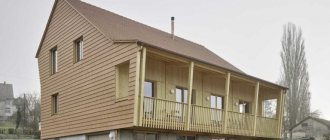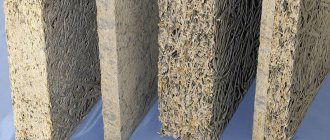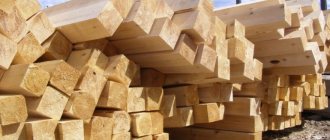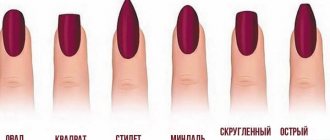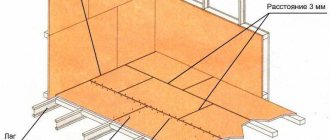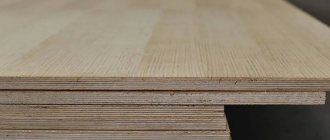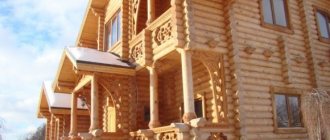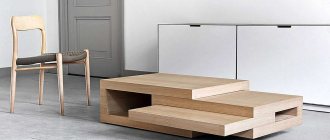Published: 06/10/2012 Category: Materials and technologies, Construction Views: 118794
Varieties of plates and sheets for covering walls, floors and ceilings
What types of slabs for construction, repair and cladding of walls, floors and ceilings exist? Their features, advantages and disadvantages. If we take frame houses as an example, the durability and appearance of such houses directly depend on the panels used for interior and exterior cladding. Moreover, the use of panels with finished finishing or a layer of thermal insulation (sandwich panel) significantly reduces the already short construction time of a prefabricated frame house.
Chipboard
Chipboard is made by hot pressing wood shavings with binder thermoactive resins, which make up 6-18% by weight of the shavings. Resins are environmentally unsafe because they contain formaldehyde, which is harmful to humans. Based on the content of this substance, chipboards are divided into classes E1 and E2. Class E1 is more environmentally friendly; it is approved for use in the production of even children's furniture. Entirely lined chipboards do not pose any harm to health; only open edges have a harmful effect. New technologies make it possible to produce Super E class slabs, which are considered safe according to all sanitary standards. In general, the material is characterized by a fairly high density, low cost and ease of processing. Chipboard is sheathed on walls, roofs, partitions, floors are made, and used as a base for linoleum and carpeting.
Chipboard
Advantages of chipboard:
- wide range of colors, patterns, thickness;
- easy to process;
- homogeneity of structure.
Disadvantages of chipboard:
- does not hold screws and nails well, especially during reassembly;
- vulnerable to moisture;
- contains carcinogens (for example, melamine).
MDF
Medium density wood board or dry pressed fibreboard. MDF from English (Medium Density Fiberboard). It is made from wood chips, ground into flour by dry pressing, at high temperature and pressure with the addition of lignin, which is found in natural wood. Lignin makes this material environmentally friendly and resistant to fungi and microorganisms. MDF boards come in thicknesses from 3 to 30 mm and are laminated with plastics, varnished or veneered. In terms of moisture resistance and mechanical characteristics, MDF is superior to natural wood and chipboard. MDF is also 2 times stronger and holds screws better. MDF is used for finishing premises, for example, in the form of wall panels or laminated flooring - laminate, in the production of furniture, speaker cabinets. MDF has a homogeneous structure, is easy to process, and very durable.
MDF Medium Density Wood Board or Dry Pressed Fiberboard
Advantages of MDF:
- fire resistance;
- biostability;
- high strength;
- holds screws better than chipboard;
- moisture resistance is higher than that of chipboard;
- wide choice of colors and patterns thanks to film and veneer coating.
Disadvantages of MDF:
- burns with the release of toxic smoke;
- Dust-like sawdust generated during processing and sawing of slabs is harmful to health.
Classification of briquetted products
In accordance with the listed technologies and equipment used for production, three types of briquettes are distinguished:
- In the form of a brick , obtained by hydropressing under pressure up to 400 bar (about 4 kgf/cm2).
- Cylindrical - about 50 cm long, 10 cm in diameter, using hydro- or mechanical pressing methods with pressure from 400 to 600 bar (4-6 kgf/cm 2 ).
- Piney-key - with radial holes, obtained by processing on screw (extruder) presses, while simultaneously exposed to high pressure (up to 110 bar) and high temperature (250-350 o C). They differ in combustion duration, increased heat transfer, density and resistance to impact.
The density of briquettes is a fundamental value that directly affects calorie content, mechanical resistance, and resistance to moisture.
Briquetted products warehouse
The higher the density, the higher the listed indicators accompanying it. Which fuel briquettes are better is up to consumers to decide, in accordance with their own needs and preferences.
Fuel briquettes RUF
This fuel resembles white or wood-colored bricks in appearance (the shade varies widely). RUF briquettes are made from dry sawdust by pressing under high pressure. As a result, Euro-firewood is born, which can be used in any type of stove. Their distinctive feature is the inscription RUF, embossed on both sides.
RUF fuel briquettes for heating stoves are characterized by the release of a large amount of heat - they are almost one and a half times more profitable than firewood. They are easy to load combustion chambers and store them in stacks. Pressed bars are not afraid of moisture, but there is also no need to expose them to direct water. This fuel is supplied by many manufacturers - a typical example is. By the way, it also sells many other types of solid fuel.
Eurobriquettes PINI KAY
An interesting feature of these Eurobriquettes is their unusual shape - they resemble square pencils from which someone has taken the lead. That's why they are called "pencils". In order for it to burn with the release of a large amount of heat, a hole is made in it, increasing the draft. The “pencils” themselves look dark, as they were fired. This procedure makes them more durable and removes excess moisture.
The disadvantage of PINI KAY fuel briquettes for heating stoves is that they are more expensive than firewood and even more expensive than any other types of fuel. But they burn well, releasing a large amount of heat. They are also convenient to transport and store. Thanks to their shape, they are ideal for lighting fireplaces. Some people take them with them into the wild to use PINI KAY bars instead of wood for a fire.
Fuel briquettes from coal and peat
Peat and coal fuel briquettes for heating stoves are made from peat and coal, respectively. The starting materials are formed into small cylinders. The fuel can be used to light stoves and solid fuel boilers. Coal products give a high combustion temperature, but are characterized by high ash content. As for peat fuel, it is ideally suited for long-burning stoves, but it also produces a lot of ash.
If you have a stove that needs something to heat, we recommend that you use PINI KAY or RUF fuel briquettes. They are distinguished by their convenience and high calorific value, form a minimum of ash and provide long-lasting combustion.
Simple cylindrical briquettes
The simplest fuel briquettes for heating stoves are also on sale - in the form of cylinders. They are made from pressed sawdust and small wood waste. All this is pressed under slight pressure using a non-toxic adhesive base, after which the finished bars are sent to consumers. This fuel is cheap, but has one distinct drawback - low strength. It easily disintegrates and crumbles and does not withstand exposure to moisture.
Drywall (GKL)
It is rightfully considered one of the most popular materials for leveling walls, ceilings and floors, installing interior partitions and even decorative elements such as arches, columns, spheroids, multi-level ceiling coverings, etc. The main component of plasterboard sheets is gypsum filler and this determines many of the positive qualities of the building material. Thus, drywall is chemically inert, its acidity is approximately equal to the acidity of human skin, it does not contain and does not release chemical compounds harmful to humans into the external environment. A standard board consists of 93% gypsum dihydrate, 6% cardboard and another 1% surfactants, starch and moisture.
Thus, the fragility of the panels complicates their transportation and loading and unloading operations. For the same reason, gypsum board cannot withstand significant physical stress and is not recommended for leveling floors. Suspended plasterboard ceilings can withstand a weight of no more than 4 kg per square meter, while suspended ceilings can bear a load of more than 100 kg per square meter.
Drywall
A variation or more modern modification of a simple sheet of plasterboard is painted or laminated plasterboard, gypsum vinyl or gypsolam - colored plasterboard with a vinyl coating. A fundamentally new material that has an initially exclusive appearance with a wide selection of decor. It is used for interior wall cladding, for covering window slopes, creating partitions, showcases and exhibition shelving, without additional finishing.
Laminated plasterboard, gypsum vinyl or gypsolam - colored plasterboard covered with vinyl coating
These environmentally friendly non-flammable panels are a gypsum board covered on both sides with special cardboard. They have ideal geometry and are used for constructing internal partitions and lining ceilings. Supplied in sheets 2700 (3000) x 1200 x 12 mm. Special grades of plasterboard are produced for wet (bathroom) and fire hazardous (wall near the fireplace) rooms. They are painted in “signal” colors - red and green. There is also plasterboard of increased plasticity (thickness 6 mm, width 900 mm) for covering rounded walls. Sandwich panels are made from plasterboard with a heat-insulating layer of polyurethane foam (up to 50 mm). They are already used for internal cladding of external walls without subsequent insulation and vapor barrier. This significantly reduces construction time.
Advantages of drywall:
- environmental and sanitary safety;
- easy to process: cut, drill;
- does not burn, but is destroyed when heated significantly;
Disadvantages of drywall:
- low strength, fragility;
- greater vulnerability to moisture, even of a moisture-resistant variety;
- does not tolerate low temperatures and significant temperature changes;
- Suitable for interior decoration only.
General information
Ready-made pressed Euro firewood is divided into types, which depend on the appearance. There are such varieties:
- RUF (size 15x9.5x6 cm, made of wood with additional components);
- Nestro (cylindrical Euro firewood with a circumference of 6-9 cm and a length of 5-35 cm);
- Pini Kay (polyhedron in shape).
All of them differ from each other only in the shape and density of the raw material. The composition and heat transfer coefficient are the same. The higher the density, the more convenient it is to compactly store fuel briquettes at home.
In addition to shavings, buckwheat, paper, small branches, straw, and leaves are used to create briquetted fuel.
The advantages of using pressed sawdust for heating include:
- Environmentally friendly. The base material is natural raw materials, and therefore ash can mineralize the soil near the plants on the site.
- Possibility of creating them at home.
- The ability to maintain combustion temperature for a long time, as well as continuous combustion for 4 hours.
- Economical fuel consumption.
- Low level of smoke generation.
- High heat dissipation.
The only drawback of Euro-firewood is their fear of high humidity.
Industrial manufacturing technology
The production of fuel briquettes from sawdust in industry takes place on specialized equipment - crushing machines. They grind the source material and prepare it for other important stages in the technology of producing fuel briquettes. It is important to prevent diseased wood or its bark from getting into the general mass.
Other steps in the manufacturing process include drying and shaping the molded products. First, the material is dried in a drum or air dryer.
Then the products are formed on a hydraulic press. It makes the mass dense without adding any binding elements to it. In the process, a natural glue, lignin, is released from the wood.
You can also press sawdust using a mechanical impact press - the simplest installation. But then the density of the fuel will be low.
Another way to produce Eurowood is extrusion. The technology consists of pushing raw materials under pressure through the holes of a screw. You can give it a cylindrical or hexagonal shape. The output is trimmed with sharp blades.
Extruders are much more productive than mechanical and hydraulic devices. However, it is not profitable to buy them to provide yourself with briquettes. Therefore, you can use other ways to obtain this type of fuel.
Plasterboard
Plasterboards are a practical, modern and environmentally friendly material, as they are made without the use of toxic substances from natural gypsum, which does not conduct electricity and is odorless. The plasterboard meets all fire safety requirements. Gypsum board, gypsum tongue-and-groove plate (GGP) is the main material in the construction of partitions, suspended ceilings, and various decorative projections. Used for leveling ceilings, walls, and “sealing” communication systems. Gypsum plaster can be moisture resistant and standard. Standard is used in buildings with normal humidity. Boards with hydrophobic additives are intended for damp rooms. Such slabs are easily distinguished by their characteristic green color.
Gypsoplate, gypsum tongue-and-groove plate (GGP)
Advantages of gypsum boards:
- environmental and sanitary safety;
- easy to process: cut, drill;
- low flammable material, flammability class G1
- relatively cheap.
Disadvantages of plasterboards:
- low strength, fragility;
- greater vulnerability to moisture, even of a moisture-resistant variety.
Gypsum fiber sheet
Gypsum fiber sheet (GVL) is a modern environmentally friendly homogeneous material with excellent technical characteristics. It is produced by semi-dry pressing of a mixture of gypsum and cellulose waste paper. In terms of its physical properties, gypsum fiber sheet is a fairly strong, hard material, also famous for its fire-resistant qualities.
Gypsum fiber sheet, due to its versatility, has become very widespread in the construction industry. It is used for the installation of interior partitions, floor screeds, suspended ceilings, wall cladding and fire protection of structures. GVL for the floor, which is used to assemble the base of the floor covering, is popular, as well as the facing option, with which, for example, wooden surfaces are sheathed, thereby increasing their fire resistance. Depending on the area of application, gypsum fiber sheets are divided into two types: GVLV (moisture resistant) and GVL (regular).
Gypsum fiber sheet. Floor installation
Advantages of gypsum fiber sheets:
- GVL, compared to gypsum plasterboard, can more easily withstand sawing in any direction, since it is homogeneous in composition;
- Higher strength due to cellulose fiber reinforcement;
- Increased sound insulation.
Disadvantages of gypsum fiber sheets:
- Less bending strength than gypsum board;
- Less suitable for interior decoration than gypsum board;
- The need for pre-treatment before painting.
Cement particle boards
Cement particle boards (CPB) are an ideal material for the outer cladding of frames and partitions in wet and flammable rooms, and serve as a good leveling base for any floor coverings. It has a hard and smooth surface, can be plastered and tiled, sawn with a hacksaw, is non-flammable, resistant to moisture and temperature fluctuations. Supplied in sheets 3600 x 1200 x 10 (12, 16, 20 and 26) mm.
Cement particle boards
Plywood
Plywood is one of the most common materials widely used in construction. Plywood is produced by gluing together several layers of peeled veneer with phenol-formaldehyde resins. For this purpose, as a rule, birch or coniferous veneer of small thickness is used. The choice of these species is due to their wide distribution in our forests: in Europe, New Zealand and some other countries, oak, maple, hornbeam and even pear are widely used for the production of various types of plywood. Veneer gluing is carried out under pressure at elevated temperatures. The resulting sheets are cooled, and after a short period of curing, they are collected in packages of 10 or 20 pieces.
Depending on the wood and glue used in the production of plywood, it is classified into:
- plywood with increased moisture resistance (FSF)
- medium moisture-resistant plywood (FC)
- bakelized plywood (BF)
Plywood
Laminated plywood is plywood lined on one or both sides with a paper-resin coating. This coating very effectively prevents the penetration of moisture, is highly resistant to abrasion and the formation of mold and mildew, and is resistant to corrosion and destruction. This type of plywood is quite popular due to lamination. Using lamination, you can apply almost any pattern or imitation: oak, poplar, maple, birch, walnut, pine and larch.
Laminated plywood
Advantages of plywood:
- high tensile and bending strength;
- Excellent sawing, drilling and fastening with both nails and screws;
- relatively inexpensive material.
Disadvantages of plywood:
- resins used for gluing veneer contain a fairly high concentration of phenolic compounds;
- flammability;
Oriented Strand Board
Oriented strand board (OSB) produced by pressing chips up to 0.7 mm thick and up to 140 mm long under high pressure and temperature using a small amount of adhesive resin. OSB boards are 3 times stronger than chipboard and MDF boards due to the arrangement of chips longitudinally in the outer layers and transversely in the inner ones. With such strength, OSB is a very flexible material and is excellent for construction and finishing work. OSB boards of various thicknesses (from 6 to 30 mm) are used to sheathe attics, ceilings, walls, and are used to make subfloors, formwork, wall panels, fences and collapsible structures. For laminate flooring, the thinnest slabs are usually used - 6 and 8 mm thick, for structures and formwork thicker ones - from 10 mm. OSB-3 is a more durable version of this material, used in low-rise construction in conditions of high humidity. Also, because of its original texture, OSB is a favorite material among decorators and designers for interior decoration. OSB makes a fairly impressive design for the ceiling or elements in built-in furniture or walls.
OSB Oriented Strand Board
Along with conventional OSB boards, there is also tongue-and-groove OSB - a board with machined groove and tongue ends, on 2 or 4 sides.
OSB tongue and groove - board with machined ends groove - tongue
Advantages of OSB:
- strength relative to other slabs used;
- moisture resistance is higher than that of chipboard and gypsum board;
- wide size range;
- cheaper than chipboard;
- holds screws well, even when screwing in again.
Disadvantages of OSB:
- it is processed worse than chipboard due to the heterogeneity of the structure;
- dust released when cutting OSB irritates the mucous membranes of the nose and eyes.
- contains formaldehyde, especially in moisture-resistant boards.
Comparison of “Eurowood” with conventional solid fuel
The cost of coal, firewood or pressed sawdust used for heating varies depending on the region. Therefore, there is no clear decision on the choice of one type of fuel or another. It is necessary to take into account the current price and conduct an analysis of comparative characteristics.
Specific calorific value of fuel
One of the main indicators of fuel efficiency is its specific calorific value (specific heat of combustion). This parameter determines how much mass fraction of a substance, when burned, will be required to release a certain amount of energy.
Comparative calorific value of various types of fuel. The values given are approximate and depend on many factors. But in general, the table shows the rating of solid fuels by specific calorific value
There is one nuance here: calorific value depends on mass, and firewood and sawdust briquettes are usually measured in cubes. When advertising compressed fuel, they often indicate that the energy output is almost twice as high as when burning wood, but they do not indicate the fact that the weight of dry briquettes per cubic meter is greater.
Let’s assume that the calorific value of freshly cut birch is about 2 kcal/kg, and that of briquettes is 4 kcal/kg. The weight of a folded cube of firewood is about 570 kg/m3, and the weight of the same volume of pressed material is about 800 kg. Therefore, a cubic meter of raw chopped wood when burned will give about 1.14 mCal, and briquettes - about 3.2 mCal, that is, almost three times more.
The thermal efficiency of industrially produced briquettes can be compared with charcoal or coal, but the latter is much cheaper.
Storage and ease of use
One of the disadvantages of pressed raw materials is its high hygroscopicity. The intense ability to absorb moisture leads to a loss of rigidity between the bound particles and possible crumbling of the briquette. Therefore, unlike coal or firewood, sawdust must be stored in a dry place.
However, in winter, pressed fuel can be kept under an ordinary canopy, since at sub-zero temperatures the absolute air humidity is low. You just need to ensure there is no direct contact with snow.
Fuel briquettes can also be kept indoors. Industrially produced pressed raw materials practically do not produce waste, unlike the same firewood.
Due to the dirt and dust created, coal and firewood are stored outside. Neat briquettes made from shavings can be kept in the veranda of your home
Pressed wood requires a minimal amount of ignition material to start burning. Here sawdust, like peat, has no competition.
Application in long-burning boilers
Nowadays, long-burning boilers are deservedly popular, especially among cottage owners. They are economical, have high efficiency and are easy to operate. Their only significant disadvantage is the cost of the equipment and the costs of its installation.
Many advanced boiler models are equipped with an automated fuel loading system. For its operation, it is necessary to use a combustible material of uniform shape. For this purpose, pellets are made from sawdust and shavings.
Pellets are made from wood waste by pressing. They have the form of granules with a diameter of 6-9 mm and a length from 10 to 70 mm
The use of this type of fuel in such boilers allows maintaining the required temperature without human intervention. This allows cottage owners to be away for a long period (up to several days) without the risk of the home cooling to unacceptable levels.
Glass magnesium sheet
Glass-magnesium sheet or glass-magnesite sheet (SML) is white, reinforced with fiberglass, 40 percent lighter than GVL, flexible, durable, fire-resistant, moisture-resistant. Thanks to the reinforcing fiberglass mesh, the SML can bend with a radius of curvature of up to three meters. This quality allows it to be used on uneven surfaces. High moisture-resistant qualities allow it to be used in rooms with high humidity. Any finishing materials can be glued to the front side of the slab. With a sheet thickness of 6mm, it is capable of holding fire for 2 hours and can withstand heating up to 1500 degrees. Sheet thickness: 3-20 mm.
Glass-magnesium sheet (FMS) is a universal sheet finishing material based on magnesite and fiberglass. The manufacturing technology and composition of the material give it such qualities as flexibility, strength, fire resistance and moisture resistance. Its qualities allow it to be used on uneven surfaces and reduces the possibility of sheet fracture during installation and transfer. In addition, this material is environmentally friendly, does not contain harmful substances and asbestos, and does not emit toxic substances even when heated. Unlike plasterboard, SML-Premium class belongs to low-combustibility materials (NG).
The scope of application of glass-magnesium sheet is extremely high. Like plasterboard, it can be used to make ceilings, walls and interior partitions. Moreover, glass-magnesite sheets can be used to decorate the external facades of cottages and houses. SML is a reliable basis for any type of finishing. The new material is ideal for showers, saunas, and swimming pools - after all, the glass-magnesium sheet can withstand high humidity, temperature changes and open fire. A wide variety of putties, paints, and adhesives can be applied to the surface of LSU. You can stick wallpaper, aluminum-composite panels, veneer, plastic, ceramic, glass or mirror tiles.
The front (smooth) surface of the sheets is intended for painting, wallpapering, laminating and applying various types of decorative textures without preliminary, final puttying and priming of the entire surface of the material. The back (rough) surface of the sheets is intended for strong adhesion when gluing piece facing and decorative materials (ceramic or tiles, veneer, etc.), or the material itself to walls and floors, gluing sheets together. LSU can be mounted on a mounting system made of both metal and wood. And also directly onto the enclosing structure using glue.
laminated glass-magnesium sheets with a variety of patterns and thickness of the outer coating have recently begun to appear more and more often
SML Glass magnesium sheet, glass magnesite sheet or glass magnesite
Advantages of glass magnesite:
- Moisture resistance - does not undergo deformation, does not swell and does not lose its properties;
- Fire resistance - magnesite panels are non-flammable material;
- Good sound insulation - a 12mm panel in terms of sound permeability corresponds to four layers of twelve millimeter plasterboard sheet, or a 150mm thick brick wall;
- High strength and flexibility - can bend with a radius of curvature from 25 cm to 3 meters;
- Lighter than similar slabs made of wood or gypsum;
- Low thermal conductivity, can be used as additional insulation;
- Can be used for finishing both outside and inside.
Disadvantages of glass magnesite:
- More fragile than gypsum fiber sheet;
- When filling joints, it is necessary to use putties with chemical adhesives;
- Properties vary significantly depending on the manufacturer and class of LSU.
The nuances of making and using briquettes
The idea of using sawdust and wood shavings for heating is not new. This type of fuel, along with wood and coal, is often used for combustion in furnaces.
The shape and subtleties of manufacturing pressed fuel
The chemical structure of sawdust and shavings is identical to the tree species from which they were obtained. Typically, birch and conifers such as pine, spruce, larch, fir and cedar are used in woodworking. It is less common to find waste from ash, oak and other “expensive” species.
Loose combustible material has a number of disadvantages:
- Dirt. Scattered sawdust and small wood debris quickly litter the area. Therefore, the area of their use as fuel is often limited to non-residential objects for which cleanliness is not important: fireplaces, greenhouses and various household premises.
- Suspend. When sawdust is stored, the smallest particles become airborne. The dust they create is harmful to health, as it provokes the development of lung diseases. In addition, a high concentration of flammable substances is explosive and therefore the use of small wood waste without adequate ventilation (which leads to additional costs) is prohibited in industrial facilities.
- Rapid and uneven combustion. When burning sawdust or shavings, it is quite difficult to achieve the planned heat transfer, since it depends on the size of the material, as well as its humidity and tree species.
All these problems can be solved by compressing wood waste into briquettes.
The shape and size of compacted waste may vary depending on the manufacturer. Therefore, you can easily choose convenient briquettes for a specific firebox.
Wood consists of 20-30% lignin, which holds fiber together. When high pressure is created using a press, this natural polymer is released, which quite firmly binds the sawdust placed in the form.
When using industrial equipment for the production of briquettes from sawdust or shavings, creating high pressure in the mold ensures the necessary density and hardness of the structure. When using less powerful homemade devices, binders such as clay or cheap wallpaper glue are added to wood waste to add strength to the products.
Features of using sawdust in heating
The chemical composition of firewood and compressed wood waste is the same, but the physical structure is different. This largely determines the specificity of their combustion.
The porosity of briquettes makes them easy to ignite. This allows you to regulate the intensity of heat transfer. Pressed, like dried rotten wood (rotten), can slowly smolder without the risk of complete extinction.
The pressed structure facilitates the ignition process. Sometimes a small amount of fuel briquettes made from sawdust and shavings is specially purchased for this purpose.
To reduce heat generation when using briquettes, you need to reduce the supply of oxygen - close the inlet.
If necessary, increase the combustion intensity - open the firebox to fresh air. Pressed waste reacts to such changes much faster than firewood.
Fiberboard boards
Fibrolite is a board material made by pressing special wood fiber (wood wool) and an inorganic binder (magnesium binder). The fiber is obtained from waste from the wood processing industry, as a result of processing on wood planing machines. One of the advantages of fiberboard boards is their low volumetric weight. Fiberboard is fire resistant: the shavings are impregnated with cement, and when exposed to fire, only soot is formed. The material allows for various finishing options, is easily attached to any structure using nails, screws, dowels, and can be easily sawed.
Fiberboards are a fire-resistant, bioresistant material that is used as thermal insulation, structural, thermal insulation and acoustic materials in building structures of buildings and structures with a relative air humidity of no higher than 75%.
Conventional fiberboard boards are produced with a thickness of 3-5 mm using gray cement as a binder. These boards are used for various types of thermal insulation, when constructing roofing and plastered partitions. Acoustic slabs are usually made from fine wood wool (0.75-2 mm), which improves their appearance, are not covered with anything, and are also tinted in colors that harmonize with the interior or are made using magnesite or white cement instead of gray. A composite fiberboard panel is a two- or three-layer panel with a middle layer of thermal insulation material, such as rigid foam or mineral fiber (mineral silicate wool). The thickness of the middle layer usually ranges from 15 to 140 mm, although the outer layers of fiberboard range from 5 to 20 mm in thickness. In this case, the level of thermal insulation increases significantly.
Fiberboard boards
Advantages of fiberboard boards:
- Ease of installation;
- Good insulation;
- Mechanically strong;
- Extensive decorative possibilities;
- Good moisture resistance and fire resistance;
- Soundproofing;
- Hygiene, harmless to human health and the environment;
- Do not spoil rodents and insects, does not rot.
Disadvantages of fiberboard boards:
- Low bending strength;
- Considerable weight.
Feel free to comment on the article if you have anything to add to this material. If you find errors or inconsistencies. Perhaps you know some other similar material not presented in this article?
These articles may also be of interest to you:
- Plates and sheet materials for subfloor construction
- Drywall - types and application features
- Installation of facade blocks
- Original small kitchen design
What else would you like to read?
Tags: OSB, GVL, gypsum tongue-and-groove board, gypsum vinyl, Gypsum fiber sheets, Drywall, gypsum board, Gypsum board, Medium density wood board, Chipboard, chipboard, laminated plasterboard, MDF, Oriented strand board, OSB, tongue-and-groove OSB, SML, glass-magnesite sheet, glass-magnesium sheet, plywood, fiberboard, fiberboard boards, cement-bonded particle boards
Making briquettes yourself
When making briquettes from sawdust on an industrial scale, a natural adhesive material, lignin, is released from them, which acts as glue and makes the product a monolith. At home, it is impossible to achieve such density with homemade devices using improvised means, and therefore additional components must be added when pressing. These particularly popular binders include:
- wallpaper glue;
- manure;
- clay.
The moisture content of the original wood should be below 12%, and the amount of damaged and unusable sawdust should be 5%.
Selection of raw materials and their preparation
To create such pressed fuel with your own hands, you should choose high-quality material. The basic ones are:
- sawdust;
- shavings after processing agricultural crops;
- waste paper;
- straw;
- secondary raw materials from coal and peat.
The total share of wood chips when choosing a combined composition of raw materials should not be lower than 60%. In this case, high quality combustion of the briquette is ensured.
Homemade pressing installations
Homemade sawdust making machines can be divided into the following types:
- manual;
- based on jacks;
- hydraulic.
To achieve lignin production, devices based on a lifting mechanism (hydraulic or screw type) can be used. Their main disadvantage is low performance.
In addition to the jack, which serves as a press, the machine uses a matrix and a punch. They give the finished firewood a certain shape. A DIY screw extruder simplifies the task of producing compressed fuel, but it is also much more difficult to make.
Stationary press for creating fuel
You can make a press for briquettes if you have the following spare parts:
- motor;
- bearings;
- gearbox;
- shaft;
- screw;
- heating elements;
- relay for temperature control.
If the voltage consists of three phases, then a 9 kW motor is used, and if work is to be done from a standard 220 V network, then a motor with a power of 2.5 kW will be needed. It, together with the gearbox and other components, is mounted on a welded frame.
In this installation, the auger is a special design of two components, one of which acts as a punch, and the other delivers sawdust into a specialized container for loading. The matrix is replaced by a profile pipe.
Before starting a homemade machine, the pipe should be heated to 260 °C, and the heating process of the heating elements is regulated using a relay. The disadvantage of this design is the large coefficient of heat loss into the air.
Briquette manufacturing technology
The procedure for making briquettes with your own hands is divided into several successive processes:
- Preparatory processes for raw materials and their purification.
- Grinding sawdust to a caliber of less than 0.6 cm.
- Pressing.
- Drying.
- Warehousing.
After the shavings have gone through all the preparatory processes, they are mixed with clay powder in a ratio of 10:1. Then the mass is mixed by adding a small amount of water. The mixture should be of medium thickness to hold its shape.
It is unloaded into a bunker for further briquette formation. After everything, all that remains is to dry the finished firewood.
You can artificially increase the flammability of pressed fuel by adding a little cardboard soaked in liquid to the clay.

